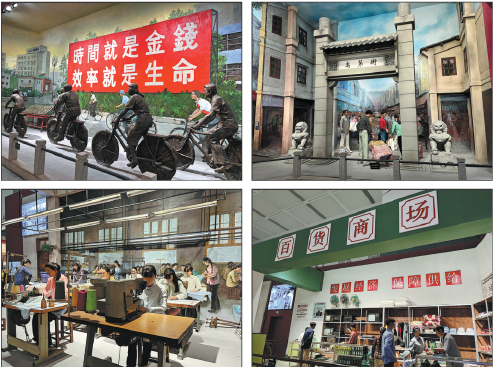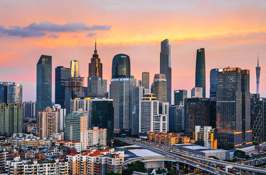Shenzhen displays a dramatic change
Exhibition showcases Guangdong's economic and social development since the country's reform and opening-up began, Zhou Mo reports.
For a few minutes, Yuan Yue stands in front of an old photo on display at the Shenzhen Reform and Opening-up Exhibition Hall, located in the city's downtown Futian district. The photo features several poorly-dressed men riding bicycles along a bumpy, muddy road.
The men, according to the caption, were workers from Xinhua bookstore who were sending books to rural areas of southern Guangdong province in the 1970s.
"I couldn't imagine how things have changed so significantly. How big a difference there is in our lives today compared to 40 years ago," Yuan sighs. "Look at the skyscrapers outside. Can you imagine that the plot of land on which we now stand was all farmland at that time?"
Yuan, 36, has been working in Shenzhen, Guangdong province, for 13 years, but it is the first time she has visited the exhibition hall and has recently watched the show, Great Tides Surge Along the Pearl River. The exhibition focuses on Guangdong's economic and social development since the country's reform and opening-up began in 1978.

Great Tides Surge Along the Pearl River, at the Shenzhen Reform and Opening-up Exhibition Hall, features Guangdong's economic and social development over the past 40 years. ZHOU MO/CHINA DAILY
The exhibition is an important window through which to showcase the history and experience of the past 40 years, says Ye Yang, head of Shenzhen Museum, who participated in the construction of the Shenzhen Reform and Opening-up Exhibition Hall.
During President Xi Jinping's visit to Guangdong province in 2018, his first stop in Shenzhen was the exhibition hall. So far, the exhibition has attracted more than 1.9 million visitors and in excess of 5,200 domestic and overseas tour groups.
Previously a small fishing village with a population of just 30,000, Shenzhen was named a special economic zone in 1980 as part of the country's reform and opening-up policy, which was initiated by former leader Deng Xiaoping.
Since then, the city has achieved a number of national "firsts", providing a role model for other cities in their ongoing development. For example, the first auction for State-owned land since the founding of the People's Republic of China was held in Shenzhen in December 1987, marking a significant reform of the country's land-use system.
In December 1990, trading on the Shenzhen Stock Exchange officially began, which has played an important role in the country's rapid capital market development over the following three decades.
Reform and opening-up is a key policy that continues to determine contemporary China's fate and future, and the objective of piloting the policy in Shenzhen was to seek happiness for its people, says Guo Wanda, executive vice-president of Shenzhen-based think tank China Development Institute.
The remarkable things Shenzhen has achieved in the process has brought the confidence and experience for other places to realize faster growth, he says.
According to official figures, Shenzhen's gross domestic product grew from less than 200 million yuan ($31.4 million) in 1979 to more than 2.7 trillion yuan last year, the fifth largest among Asian cities.
It ranked the second among all Chinese cities in comprehensive economic competitiveness for 2021, just behind Shanghai, according to a recent ranking by the Chinese Academy of Social Sciences.



 Print
Print Mail
Mail

